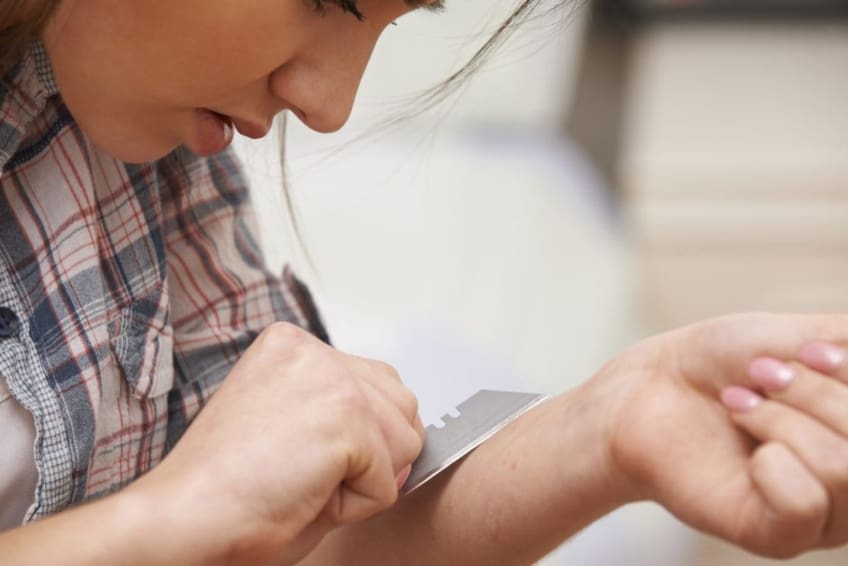
It’s difficult to watch your child experience emotional pain. It’s even more difficult to see physical signs of their pain. Cutting is the act of purposely cutting yourself with a sharp object, such as a knife or razor blade. It’s an unhealthy way to relieve emotional pain, sadness, intense frustration, and anger.
Cutting commonly occurs on the arms, legs, or torso. These are places that can be hidden by clothing. Cutting affects men and women of all ages. It usually starts in the teenage years and is more common in girls. Except in rare cases, cutting is not a sign that your child has thoughts of suicide. If you are concerned your child is cutting, learn the warning signs and speak with your child’s doctor.
Path to improved emotional well being
Even though cutting causes physical pain, people cut because they believe it brings them emotional relief. It may be in response to problems at home, school, or in other areas of their life. If your child is cutting, they may not be able to cope with their feelings. These can include loneliness, confused sexuality, deep anger, rejection, guilt, self-hatred, or panic.
Cutting is a clear sign of your child’s emotional distress. However, it usually catches most parents by surprise. Teenagers cleverly cover up their cuts. Unless you know what to look for, it may go undetected for a long period of time. Warning signs that your child is cutting include:
- Multiple, fresh cuts across the skin, and usually clustered together in the same area
- Scarring and bruising
- Having sharp objects nearby for no apparent reason
- Wearing long sleeves and pants at odd times, such as when it’s hot outside
- Making excuses about the reason for the cuts you see
Additionally, your child may be experiencing problems with a relationship. They may be making statements about poor self-worth or hopelessness. Your child may be questioning their identity and reason for living. They could be showing signs of behavioral issues, such as impulsivity and unpredictability.
If you suspect or see evidence of your child’s cutting, do not yell or criticize your child. Offer your support, express your concern, and tell them that you will do what it takes to help them with whatever is causing the urge for cutting. Speak with your child’s doctor. Your doctor will want to see your child and can provide you with referrals for treatment with a mental health professional.
Counseling or psychotherapy is commonly used to treat unhealthy coping methods, such as cutting. Counseling can take the form of one-on-one sessions with your child, family sessions, or a combination of the two. There are many different types of psychotherapy treatments, including:
- Cognitive behavioral therapy (CBT), which identifies and replaces unhealthy behaviors and beliefs.
- Dialectical behavior therapy (DBT), which teaches skills to handle, manage, or balance your emotions and improve relationships.
- Psychodynamic therapy, which helps you identify past experiences that may be at the root of your emotional stress.
- Mindfulness-based therapy, which teaches you how to live in the moment with appropriate thoughts and actions.
Your child’s therapy will depend on their emotional health and the seriousness of their cutting. Counseling and psychotherapy are not one-time treatments. It generally takes time, maybe even years, to uncover the reason for your child’s cutting and teach healthy strategies for coping.
Beyond emotional treatment, your doctor may need to treat the physical effects of cutting to reduce infection, permanent scarring, or severe (or potentially fatal) injury. Additionally, your doctor can help determine if there is an underlying medical condition (such as anxiety or depression) that may benefit from medications.
Things to consider
Continue to pay attention to your child’s friends. Research shows that people who cut spend time with friends who cut. Drug and alcohol use also increase your child’s risk of cutting. While thoughts of suicide aren’t common with cutting, your child could accidentally cut deep enough or cut an artery that could result in death if not treated immediately.
Questions to ask your doctor
- What is the best way to raise the issue of cutting with my child?
- If I confront my child about cutting, will this make them want to cut more and hide it more?
- How do I know if what I see is an accident or true cutting behavior?
- Is this behavior an inherited mental health condition?
- Should I talk to my child’s doctor before bringing them to the office?
- What if I’m wrong? Will I put the idea in my child’s head?
Resources
Centers for Disease Control and Prevention: Self-Directed Violence
![]()
Copyright © American Academy of Family Physicians
This information provides a general overview and may not apply to everyone. Talk to your family doctor to find out if this information applies to you and to get more information on this subject.







